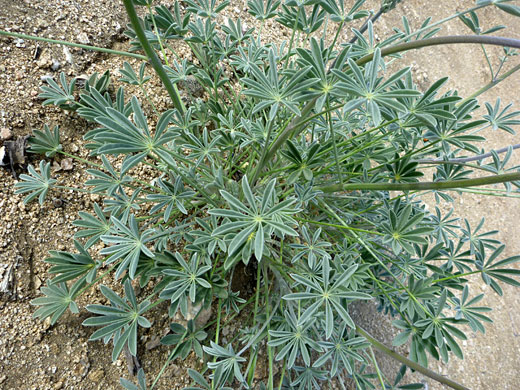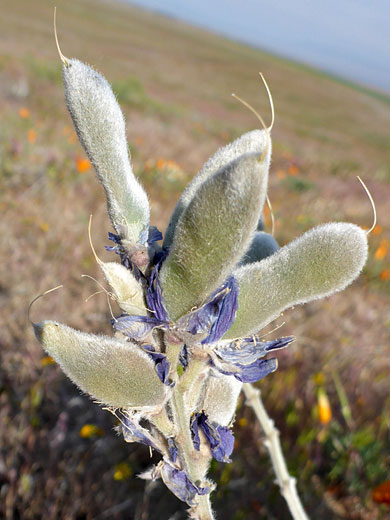
Bent flower stem - lupinus excubitus along the Panorama Trail, Joshua Tree National Park, California
Common name:
Grape soda lupine
Family:
Scientific name:
Lupinus excubitus
Main flower color:
Range:
South California and south Nevada
Height:
Up to 6 feet
Habitat:
Washes, desert slopes, sagebrush scrubland
Leaves:
Divided into 7 to 10 narrowly oblanceolate leaflets, up to 2 inches long
Season:
March to July
Lupinus excubitus is one of the taller members of this large genus, reaching heights of 6 feet or more, though usually around 3 feet. The green, palmate leaves grow mostly around the base, and appear greyish due to a covering of short, rough hairs. They have stalks which are rather longer (up to 5 inches) than the width of the blade (less than 2 inches). Like many lupines, the leaflets are often partly folded up along the axis.
The closely-spaced flowers are alternately arranged along the upper portion of the stout, ridged, reddish stems, attached via a short pedicel. The upper banner petal has a bright yellow patch at the center (fading to purple when fully mature), and is curved sharply backwards at either side. The two wing petals are cup-shaped, almost completely hiding the narrow keel petal, which is hairy along the upper margin, hairless below. Flowers bloom from the base of the cluster upwards. Fruits are silky-hairy pods up to 2 inches long, slightly constricted between the seeds.
There are five varieties of lupinus excubitus (excubitus, hallii, austomontanus, johnstonii, medius), differing in such aspects as flower width, plant height, inflorescence height and petiole length.
The closely-spaced flowers are alternately arranged along the upper portion of the stout, ridged, reddish stems, attached via a short pedicel. The upper banner petal has a bright yellow patch at the center (fading to purple when fully mature), and is curved sharply backwards at either side. The two wing petals are cup-shaped, almost completely hiding the narrow keel petal, which is hairy along the upper margin, hairless below. Flowers bloom from the base of the cluster upwards. Fruits are silky-hairy pods up to 2 inches long, slightly constricted between the seeds.
There are five varieties of lupinus excubitus (excubitus, hallii, austomontanus, johnstonii, medius), differing in such aspects as flower width, plant height, inflorescence height and petiole length.
All Contents © Copyright The American Southwest | Comments and Questions | Contribute | Site Map








